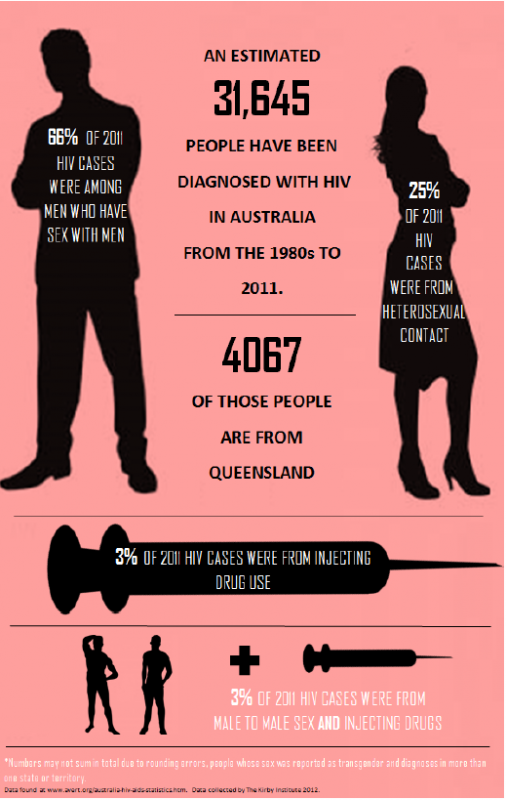HIV Stigma: Still at large
Story by Georgina Auton.
THE number of HIV cases has doubled in Queensland in the past 10 years and experts fear stigma surrounding the disease is contributing to the dramatic rise. Queensland Government health estimates show up to 1500 people could be infected with the disease across the state, but remain undiagnosed.
Medical officers say the negative stigma associated with HIV is discouraging people from being tested.
Global HIV advocate and British music legend, Sir Elton John, says the Queensland statistics are part of a wider global trend. He said he was not surprised, claiming stigmatisation and HIV go hand-in-hand.
Sir Elton said he first took up the HIV cause in the 1980s after Ryan White, a young haemophiliac from the USA, died from AIDS. Though Ryan had been contaminated through infected blood, he died ‘amid a torrent of fear and prejudice’, which made Sir Elton question the stigma surrounding HIV.
“Here was this kid, who had nothing but kindness and courage in his heart who was being vilified on a daily basis because he was HIV positive,” he said.
“I knew there must be thousands of people getting sick and dying of AIDS, silently and in shame, because of the stigma of this disease.
“We must eradicate this stigma.”
Ji Wallace, former Australian Olympic trampolining silver-medalist, said it was important to overcome the stigma.
Ji, who is openly gay, went public with his HIV positive status in 2012, and said that he made this decision because silence and fear still dominate HIV discussions.
“The first thing I wanted to do was scream at the world ‘know your status’,” he said.
“I was afraid people would treat me different.
“The stigma is where the fear lies,” he said.
Queensland is the first state in Australia to implement rapid testing, with a result taking only 20 minutes instead of a few days. Normally, after a blood test the blood has to be sent away to be tested. This means that it can take up to a few days to get a result, however with rapid testing this process is dramatically shortened.
Nonetheless, the stigma surrounding HIV still prevents people from getting tested.
Dr Darren Russell, Chair of the Ministerial Advisory Committee for HIV and AIDS, says that combatting the negative beliefs is the key to beating HIV.
“One thing that we really need to do it try and break down that stigma because A, it’s good for people who are living with HIV if they’ve got less stigma,” Dr Russell said.
“And B, if there’s less stigma…people are more likely to get tested, because they’re not scared of finding out they have it to the same degree,” he said.
Dr Russell said if Australians can be made more aware of HIV, they can take measures to prevent passing it on.
Sir Elton said that while ignorance is one of the things which has helped HIV to spread, the stigma is still the worst thing in regards to HIV.
“That’s what stops people from going for an HIV test, or asking a partner to wear a condom, or disclosing their status,” he said.
“This is not only the moral thing to do, it’s also the smart thing to do if we want to beat the epidemic,” he said.
Queensland Health Minister, Lawrence Springborg, established the Ministerial Advisory Committee for HIV and AIDS (MAC) in 2012 in order to address the rise in HIV cases in Queensland.
Mr Springborg says that in the time since its establishment, the MAC has yielded significant results.
“The MAC (sic) recently launched the E.N.D. H.I.V. campaign, which for the first time will address all angles, including education and awareness, stigma, testing, treatment and prevention,” he said.
“This pioneering three year campaign is designed to change behaviours to help put an end to HIV in Queensland,” Mr Springborg said.
Dr Russell said that the MAC is hoping that soon, fewer cases of HIV will remain undiagnosed.
“New South Wales [in 2012] showed a 25 per cent rise in diagnoses from the previous year and they’re trying to figure out if it’s just because there are new infections, or because they did a lot more testing and found a lot more people,” he said.
“I hope the new diagnoses go up [in Queensland], but I hope the new infections go down,” Dr Russell said.
Yet the humiliation caused by the HIV stigma is stopping people from getting tested.
Sir Elton said that the stigma surrounding HIV is one of the reasons why AIDS is so deadly.
“It has killed millions more than it ever needed to simply because it first came to light as being spread by unprotected sex in the gay community” he said.
“As the disease spread more widely around the world, ‘HIV’ became synonymous with promiscuous and amoral.
“This blamed and shamed people when we should have been focussing of (sic) love and treatment.”
Last year’s Australian of the Year, Ita Buttrose agrees. The HIV/AIDS advocator has been involved with many HIV and AIDS organisations in Australia since the 1980s, such as the National Advisory Committee on AIDS and the AIDS Trust Australia.
“I think I will always be involved in some way in the on-going fight against HIV and AIDS,” she said.
Dr Russell describes celebrity involvement in HIV awareness and prevention as “fantastic”.
“Anything that raises the awareness and keeps people thinking about it [is a good thing],” he said.
Nonetheless, Dr Russell says that the stigma might not be the only thing to blame for the increase in HIV cases in the past 10 years.
“I think that there are a few reasons for that,” he said.
“There is some ‘condom fatigue’; a lot of gay guys aren’t using condoms the way they were in the past.
“HIV is a lot less threatening than it used to be. I think the terror that was there in the eighties and nineties has gone.”
However, Dr Andrew Chester, a Queensland General Practitioner, says that an HIV positive diagnosis still causes negative reactions.
“Usually people are distressed with such information. Anger is generally a late stage reaction,” he said.
“The prognosis for HIV has improved over the last 10 to 15 years but still the reality is a ‘life sentence’.
“There is still great stigma surrounding HIV and AIDS- this does influence public opinion greatly.”
Ji Wallace says that his diagnosis was a shock which caused him to revaluate his life. However, he dealt with his diagnosis head on due to his prior knowledge of HIV. He says that after his diagnosis, his head felt like it was going to explode.
“Many things in my life came into focus at the time of my quick test result,” he said.
“It was six months before I could tell my parents face to face.
“That was all I really wanted to do,” he said.
These days, Ji tries to ignore the stigma, and says that his support team help to prevent people from being discriminatory to him.
On a positive note, Professor Sharon Lewin from Monash University is currently researching possible cures for HIV. She started HIV research in 1993 and says medical care is advancing.
“At the time, we thought Anti-HIV drugs might cure HIV. Unfortunately, we were very wrong,” she said.
“What the current drugs can’t do is get rid of the last bits of virus that hide in resting immune cells.
“The drugs we are now testing to get rid of the ‘hidden’ virus can only be used in combination with current antiviral drugs.”
Although HIV has not yet been cured, antiviral drugs have played a pivotal role in preventing the spread of HIV. Professor Lewin says that the ultimate goal for her research is to “have a functional cure for HIV that is available in all countries to all people- rich or poor”.
Ji Wallace said that if he could speak to someone newly diagnosed with HIV, he would tell them that they will be ok. He said that huge medical advancements mean that people with HIV can live their life to the fullest.
“Educate yourself on HIV, get yourself on a treatment plan and go, go get the life you want,” he said.
“You don’t want HIV but if you find yourself with a positive diagnosis, you need to put together a plan to keep on living your life out there big and at its best.”

